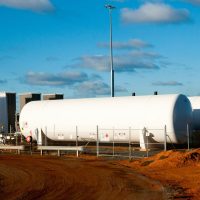AST Regulations vs. UST Regulations

When it comes to storing hazardous substances, the type of storage tank you use matters—not just for efficiency and safety but also for compliance with state and federal regulations. Herbert Lutz & CO. understand the key differences between Aboveground Storage Tanks (ASTs) and Underground Storage Tanks (USTs) and can help industries and property owners with the regulations that govern them in New Jersey and Florida.
What Are ASTs and USTs?
Aboveground Storage Tanks (ASTs) are storage containers located above the earth’s surface. They are often used for storing petroleum products, chemicals, and other hazardous materials.
Underground Storage Tanks (USTs), on the other hand, are storage tanks buried underground, commonly used for storing gasoline at service stations.
Regulatory Oversight
Both ASTs and USTs are subject to federal regulations, primarily overseen by the Environmental Protection Agency (EPA). The EPA sets the baseline standards, but states have the authority to impose stricter rules.
In New Jersey, the Department of Environmental Protection (NJDEP) oversees both AST and UST regulations. Florida’s Department of Environmental Protection (FDEP) serves a similar role.
ASTs: Spill Prevention, Control, and Countermeasure (SPCC) Plan
One of the primary federal requirements for ASTs is the development of a Spill Prevention, Control, and Countermeasure (SPCC) Plan. This plan outlines the measures to prevent oil spills into navigable waters or adjoining shorelines.
In New Jersey, ASTs must adhere to the Discharge Prevention, Containment, and Countermeasure (DPCC) program, which is even more stringent than the federal SPCC plan.
Florida has specific construction standards for ASTs, including requirements for dikes, walls, and secondary containment systems.
USTs: Leak Detection and Reporting
USTs, in contrast, must have leak detection systems in place, and any leaks must be reported immediately to state agencies. USTs must also be registered with the state, and permits must be obtained for their installation, operation, and removal. Owners and operators of USTs must demonstrate financial responsibility to cover the costs associated with cleaning up leaks and compensating third parties for damages.
Compliance and Penalties
Non-compliance with either AST or UST regulations can result in hefty fines and even criminal charges. Penalties vary by state and can be severe.
Which is Easier to Manage: AST or UST?
The answer depends on various factors, including the type of substance being stored, the location of the facility, and the available resources for compliance. ASTs generally require less rigorous leak detection systems but may require more extensive secondary containment measures. USTs, while not visible to the public, come with their own set of challenges, including stringent leak detection and reporting requirements.
Contact Herbert Lutz & Co. for Help With Regulatory Compliance in New Jersey and Florida
Both ASTs and USTs come with their own sets of regulations and challenges. While federal laws provide a baseline, state-specific regulations in New Jersey and Florida add another layer of complexity. Understanding these regulations is crucial for any facility that uses storage tanks for hazardous materials. Failure to comply can result in severe penalties, not to mention the potential environmental impact.
For more information on how to navigate the complex landscape of AST and UST regulations, consult with certified professionals at Herbert Lutz Co., Inc. in New Jersey at 908-862-8888 or Lutz Petroleum in Florida at 954-971-5222. We have the expertise to ensure that your storage tanks meet all federal and state regulations, minimizing risks and maximizing safety.